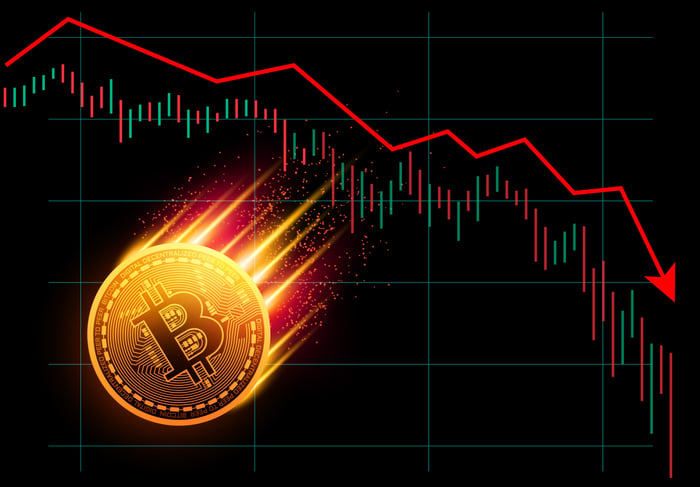What a difference six months make.
Last year, cryptocurrencies simply couldn't be stopped. After beginning the year with an aggregate market valuation of just $17.7 billion, digital currencies soared to end the year with a combined market cap of $613 billion. That's a gain of more than 3,300%, for those of you keeping score at home, and very likely represents the single greatest year on record for any asset class.
Though this momentum continued until Jan. 7, 2018, with the aggregate market cap hitting an all-time high of $835 billion, the past roughly six months haven't been pretty. Led by bitcoin, Ethereum, and Ripple, cryptocurrencies have mostly been throttled across the board. Last week, the aggregate cryptocurrency market cap hit an intraday low of $232 billion, which is its lowest level in seven months, and representative of a 62% peak-to-trough decline since the year began.

Image source: Getty Images.
Because of the rapid rise, and seemingly faster decline, of virtual currencies, cryptocurrencies have begun to draw regular comparisons to the dot-com crash in the early 2000s that wiped 78% off of the Nasdaq Composite from peak to trough. Of course, the Nasdaq also rebounded in a big way off of its lows following the dot-com bubble, lending hope to crypto enthusiasts that this burgeoning asset class has a bright future.
The craziest virtual currency statistic of 2018
But one thing is unmistakable throughout the recent carnage: a growing number of cryptocurrencies have proven to be nearly worthless, according to a recent Bloomberg report. In what's easily the craziest cryptocurrency statistic you'll see all year, Dead Coins lists 820 digital currencies and initial coin offerings (ICO) as either "deceased" or in its "parody" category, while Coinopsy has a list of nearly worthless coins that currently exceeds 1,000.
For added context, CoinMarketCap.com only lists around 1,600 investable tokens. This means that well over half of all investable cryptocurrencies and ICOs are scams, or have been abandoned. Whatever the reason, more than half of all investable digital tokens are now practically worthless.
Interestingly enough, a growing list of dead coins shouldn't really surprise anyone. A March analysis published by the Satis Group found that 81% of ICOs with a market cap in excess of $50 million were nothing more than scams and essentially on their way to the digital graveyard. Meanwhile, just 3.8% of the ICOs it analyzed were considered a success. Per the Satis Group, "success" meant that the developers behind a token were successful in terms of raising capital, fulfilling the development of a blockchain as outlined in a white paper, and had a code contribution in Github over a rolling three-month basis.

Image source: Getty Images.
Dead coins are just one of a growing list of problems for cryptocurrencies
While thinning the herd, so to speak, is a good start for the digital currency space, it's just the first step of many that'll need to be taken in order to instill confidence in a market that's generated pretty steady losses this year.
Arguably the biggest challenge is going to be overcoming the proof-of-concept conundrum with regard to blockchain technology. Blockchain is the digital, distributed, and decentralized ledger that underlies nearly every digital token and is responsible for processing transactions without the need for a financial intermediary, as well as logging data in an immutable (i.e., unchanging) way.
Throughout numerous small-scale tests, blockchain has shown its ability to process and settle transactions quickly and accurately. The issue is that blockchain's training wheels have never been taken off. In essence, these tests have always been conducted within defined parameters. Without having demonstrated its ability to scale, no businesses are willing to abandon their existing infrastructure in favor of blockchain. Then again, the only way blockchain can prove its scalability is if businesses give the technology a chance in the real world. This Catch-22 isn't going to be easy to overcome, and cryptocurrency investors likely realize it.
Regulation has also been a bit of a double-edged sword for virtual currencies. On one hand, investors and digital token users have thrived off of the lack of traditional regulation with cryptocurrencies. Recently, William Hinman, the director of the Division of Corporate Finance at the Securities and Exchange Commission (SEC), stated in a speech at the Yahoo All Market Summit: Crypto conference that neither bitcoin nor Ether (the token used to pay for transactions on Ethereum's network) would be classified as securities by the SEC due to their decentralized networks. The classification means no stringent regulations will be placed on either token.

Image source: Getty Images.
Though this news might seem like a win, it really isn't. Without tight regulations on the crypto space, fraudulent activity and thefts have been quite common. What's more, without any sort of well-defined regulation, the SEC's hands are tied should fraud occur. With transactions often happening outside the borders of the U.S., the SEC may have little recourse to retrieve your funds.
Digital currencies are also struggling to find their purpose. For example, bitcoin may be the largest digital token by market cap, but consumers have very little reason to switch from cash or credit to bitcoin. With the exception of needing to purchase bitcoin as an intermediary currency when buying lesser-known tokens on a decentralized exchange, bitcoin lacks a well-defined utility. Without genuine purpose, cryptocurrencies are likely going to struggle to attract long-term investors.
At this point, with such a long list of issues, it wouldn't be surprising if the aggregate value of cryptocurrencies continued to fall.




